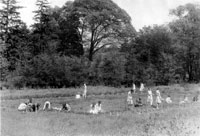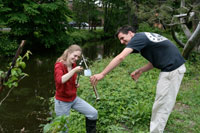The History of Environmental Studies at Vassar College
by Elizabeth Jones (’11) with contributions from H. Daniel Peck, Professor of English
March 2011
Program Website
Environmental Education at Vassar, 1865-1995
“The region around must not only be healthy, in fact, but must have an established and unquestioned reputation for purity of air, wholesome waters, and all other conditions on which the public health depends.” These words were written in the late 1850s by Milo P. Jewett, who was to become Vassar College’s first president, to founder Matthew Vassar, then engaged in choosing a site for the new college.
Thus, from the start, environmental concerns have been central to Vassar, and they immediately informed its curriculum. Soon after the college opened in 1865, faculty members such as Charles Farrar and Sanborn Tenney developed natural history studies. James Orton, a Darwinist who in the 1860s brought back zoological, botanical, and geological specimens from an expedition in South America, was one of the most influential of the natural history faculty. Orton’s specimens greatly enhanced the Vassar Natural History Museum’s holdings, which were eventually located in New England Building, the current home of the Environmental Studies Program.
Nineteenth century Vassar graduates distinguished themselves in environmental careers. Notable alumna included Ellen Churchill Semple, class of 1882 (honored in a major symposium at Vassar in 1992), who became known for her field investigations as the “dean of American geographers,” and Ellen Swallow Richards, class of 1870, the first American to use the term “ecology,” and creator of Euthenics, the first interstudies course at Vassar. Euthenics, or the study “of adaptation of the individual to environment,” concentrated on the application of scientific principles to the protection of air, water, and food, and to the elimination of pollutants. Although the Euthenics program moved away from the study of the natural environment to focus more on the subject of child development, it did lead to some enduring improvements of local environmental health. An expert on water pollution, Richards eventually convinced Vassar to stop discharging its sewage into the Casperkill and Fonteynkill streams, and to instead create a filtration system to handle the campus waste. In 1895 John Guy Vassar, Jr., Matthew Vassar’s nephew, gifted his uncle the first 200 acres of the Vassar Farm for this purpose.
Natural history at Vassar during the nineteenth and early twentieth century also benefited from a strong artistic dimension. The famous literary naturalist John Burroughs made his first visit to the college in 1879, bringing poet Walt Whitman with him. This was the beginning of a long association between Burroughs and Vassar faculty and students, many of whom made visits to Burroughs’s retreat Slabsides, located just across the Hudson River from Vassar in West Park, New York.
During the long and influential presidency of Henry Noble MacCracken (1915-1946) there were several important developments in ecology and the interdisciplinary study of the environment. In 1920 botany professor Edith A. Roberts founded the Dutchess County Outdoor Ecological Laboratory, and in 1929 she published her book American Plants for American Gardens. Professor Roberts’ work aimed to encourage the use of native plant associations among the general public. In this period, faculty dedicated attention to urban and health aspects of environment; President MacCracken himself founded the first county public health organization in the United States. In 1924, Vassar initiated a summer program focused on public health issues and community planning, and in 1937 a “social museum” for the study of urban environments was instituted, with Eleanor Roosevelt participating in one of its first projects.
Environmental thinking flourished at Vassar in the 1940s, 1950s, and 1960s, partially as a result of the rise of the environmental movement in the United States during this period. In 1941 a generous endowment established the Helen Gates Putnam (class of 1892) Graduate Division of Conservation, which was coordinated by the departments of zoology, geology, plant science, and psychology. The Conservation Division supported master’s students at Vassar through the 1960’s, and Dr. Ralph Palmer was hired to teach relevant courses and work in the Natural History Museum. In 1951 the departments of Plant Science, Geology, and Zoology developed an interdepartmental course in Conservation and invited influential speakers such as Dr. John Curtis, an Ecologist from the University of Wisconsin. In 1957, the college hosted a major conservation conference, “The Partnership of Man and Nature,” and in this period the curriculum reflected new, post-war environmental concerns.
In the late 1960s, the environmental movement in the US moved away from a narrow focus on issues of pollution and adopted a more comprehensive perspective. Vassar’s curriculum developed in accordance with this shift. One of Vassar’s foundational interdisciplinary courses dealing with the environment was “The River,” coordinated in the 1960s by Political Science Professor Charles Gordon Post. This course treated “the Mid-Hudson region as a case study in man’s relation to his environment.” Professor Scott Warthin’s course, “Geological Aspects of Conservation,” which he offered from the 1940s through the 1960s, also deeply influenced several generations of Vassar students. Among them were Elizabeth Titus Putnam, class of 1955, and Martha Hayne Talbot, class of 1954, who after graduating collaborated to form a national organization, the Student Conservation Association.
Two important developments occurred during the 1970s: the founding of several multidisciplinary programs, such as the American Culture Program, whose innovative curricular structures would later inform the development of Vassar’s new Environmental Studies program, and the development of an ecological preserve on the campus. In 1976, the Board of Trustees assigned 280 acres on the Vassar Farm for use as an ecology study field site for the education of Dutchess County school children. This site was extensively developed in the 1990s during the establishment of the Environmental Science Program, and became the Vassar Ecological Preserve, where today Vassar faculty and students conduct a wide range of research projects. Construction of the Priscilla Bullitt Collins Field Station, on the Preserve, was completed in 1995.
Development of Vassar’s Environmental Studies Program, 1995-Present
Vassar’s new multidisciplinary program in environmental studies is the result of an intensive development effort that began in 1995, when a small group of faculty began to meet. In the spring 1996, this group submitted a funding proposal to Priscilla Bullitt Collins, class of 1942, who was visiting the campus to dedicate the ecology field station that bears her name. Mrs. Collins responded with a generous development grant that, during a four-year period supported a number of initiatives designed to test the interest of faculty and students, and to help faculty in all fields discover the relationship of their scholarship and teaching to environmental studies. These initiatives included team-taught experimental courses, a lecture series, and a faculty seminar. The seminar, in which Vassar faculty and outside speakers gave presentations, involved as many as one-third of the faculty, and represented almost every department on the campus. Contemporaneous with these developments was a conference on environmental literature, funded by the National Endowment for the Humanities, that Vassar hosted in 1997.
The program that emerged from the development project was approved by the faculty in December of 1999 and received New York State certification early in 2000. H. Daniel Peck, John Guy Vassar Professor of English and a Thoreau scholar, was named the first director. From that point on the directorship of the program has rotated among academic disciplines to reflect the multidisciplinary nature of the department, which emphasizes the natural sciences, the social sciences and the humanities equally. Following the incorporation of the pre-existing Environmental Science correlate into the new Environmental Studies program, faculty created the Environmental Research Institute to assure that the natural sciences would be well represented within the program. The Environmental Research Institute, a research and public outreach wing of the environmental studies program that promotes fieldwork and aims to foster engagement with the local community.
Over the last decade the Environmental Studies program has continued to expand and flourish. In 2003, the Environmental Studies office was given an award-winning green renovation, in which architect Dennis Wedlick turned a portion of the late 19th century New England building into a showcase of sustainability. The Environmental Research Institute was strengthened in 2006 with the addition of the Collins Fellow, a full-time position dedicated to research on local environmental issues. The Collins Fellow position has been instrumental in the success of the Casperkill Assessment Project, a long-term research study on the health of the nearby Casperkill Creek and its watershed. In 2008, Collins Fellow Kelsey Smith started a citizens group, the Casperkill Watershed Alliance. This group has helped to strengthen the ties between Vassar College and members of the Poughkeepsie community in order to collectively improve the ecological health of our watershed. Finally, the Environmental Studies department has been enhanced in recent years with incorporation of field trip courses to national and international locations. These courses reflect an acknowledgement of the growing global scale of environmental issues.
Sources
Daniels, Elizabeth A., Bridges to the World, Henry Noble Macracken and Vassar College, Clinton Corners, 1994
Linner, Edward R. ed. E.A. Daniels, Vassar. The Remarkable Growth of a Man and his College 1855-1865, Poughkeepsie, 1984
Vassar College Encyclopedia article, James H. Orton
Vassar College Encyclopedia article, Ellen Swallow Richards
Vassar College Encyclopedia article, Vassar Farm and Ecological Preserve








